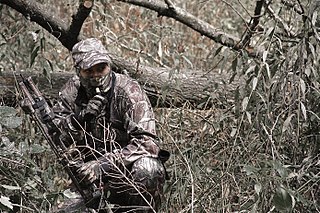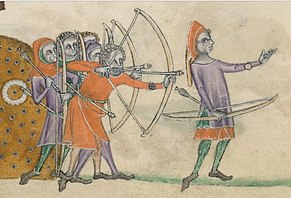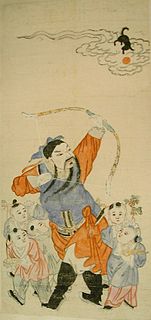
Archery is the art, sport, practice, or skill of using a bow to shoot arrows. The word comes from the Latin arcus, meaning bow. Historically, archery has been used for hunting and combat. In modern times, it is mainly a competitive sport and recreational activity. A person who participates in archery is typically called an archer or a bowman, and a person who is fond of or an expert at archery is sometimes called a toxophilite or a marksman.

A crossbow is a ranged weapon using an elastic launching device consisting of a bow-like assembly called a prod, mounted horizontally on a main frame called a tiller, which is hand-held in a similar fashion to the stock of a long firearm. Crossbows shoot arrow-like projectiles called bolts or quarrels. A person who shoots crossbow is called a crossbowman or an arbalist.

The English longbow was a powerful medieval type of longbow about 6 ft (1.8 m) long used by the English and Welsh for hunting and as a weapon in warfare. English use of longbows was effective against the French during the Hundred Years' War, particularly at the start of the war in the battles of Sluys (1340), Crécy (1346), and Poitiers (1356), and perhaps most famously at the Battle of Agincourt (1415). However they were less successful after this, with longbowmen having their lines broken at the Battle of Verneuil (1424) though the English won a decisive victory, and being completely routed at the Battle of Patay (1429) when they were charged by the French mounted men-at-arms before they had prepared the terrain and finished defensive arrangements. The Battle of Pontvallain (1370) had also previously shown longbowmen were not particularly effective when not given the time to set up defensive positions.

Shooting sports is a collective group of competitive and recreational sporting activities involving proficiency tests of accuracy, precision and speed in shooting — the art of using various types of ranged firearms, mainly referring to man-portable guns and bows/crossbows.
The bow and arrow is a ranged weapon system consisting of an elastic launching device (bow) and long-shafted projectiles (arrows).
The Worshipful Company of Bowyers is one of the Livery Companies of the City of London.

Bambi is a 1942 American animated drama film directed by David Hand, produced by Walt Disney and based on the 1923 book Bambi, a Life in the Woods by Austrian author and hunter Felix Salten. The film was released by RKO Radio Pictures on August 13, 1942, and is the fifth Disney animated feature film.

A composite bow is a traditional bow made from horn, wood, and sinew laminated together, a form of laminated bow. The horn is on the belly, facing the archer, and sinew on the outer side of a wooden core. When the bow is drawn, the sinew and horn store more energy than wood for the same length of bow. The strength can be made similar to that of all-wood "self" bows, with similar draw-length and therefore a similar amount of energy delivered to the arrow from a much shorter bow. However, making a composite bow requires more varieties of material than a self bow, its construction takes much more time, and the finished bow is more sensitive to moisture.

Bowhunting is the practice of hunting game animals by archery. Many indigenous peoples have employed the technique as their primary hunting method for thousands of years, and it has survived into contemporary use for sport and hunting.

James Maurice Thompson was an American novelist, poet, essayist, archer and naturalist.

Fred Bear was an American bow hunter, bow manufacturer, author, and television host.
The Strategikon or Strategicon is a manual of war regarded as written in late antiquity and generally attributed to the Byzantine Emperor Maurice.
Lida Scott Howell was an American female archer who competed in the early twentieth century. She won three gold medals in Archery at the 1904 Summer Olympics in Missouri in the double national and Columbia rounds and for the US team.

William Adolph Baillie Grohman (1851–1921) was an Anglo-Austrian author of works on the Tyrol and the history of hunting, a big game sportsman, and a pioneer in the Kootenay region of British Columbia.

Archery, or the use of bow and arrows, was developed by the end of the Upper Paleolithic or earlier. Archery has been an important military and hunting skill for over 10,000 years and figures prominently in the mythologies of many cultures. Archers, whether on foot, in chariots or mounted on horses were a major part of most military forces until they began being gradually supplemented, then replaced, by firearms in the Late Middle Ages and in the early modern period. Gunpowder, which was first developed in China in the 9th century AD, was initially used to enhance projectile weapons including arrows. Firearms diffused throughout Eurasia by the gunpowder empires, gradually reducing the importance of archery in warfare.

In the United Kingdom, the term hunting with no qualification generally refers to hunting with hounds, e.g. normally fox hunting, stag (deer) hunting, beagling, or minkhunting, whereas shooting is the shooting of game birds. What is called deer hunting elsewhere is deer stalking. According to the British Association for Shooting and Conservation (BASC) over a million people a year participate in shooting, including stalking, shooting, hunting, clay shooting and target shooting. To undertake shooting in the UK a valid firearms licence and insurance is required.

Field archery is any archery discipline that involves shooting at outdoor targets of varying and often unmarked distance, typically in woodland and rough terrain.

For millennia, Chinese archery has played a pivotal role in Chinese society. In particular, archery featured prominently in ancient Chinese culture and philosophy: archery was one of the Six Noble Arts of the Zhou dynasty ; archery skill was a virtue for Chinese emperors; Confucius himself was an archery teacher; and Lie Zi was an avid archer. Because the cultures associated with Chinese society spanned a wide geography and time range, the techniques and equipment associated with Chinese archery are diverse. The improvement of firearms and other circumstances of 20th century China led to the demise of archery as a military and ritual practice, and for much of the 20th century only one traditional bow and arrow workshop remained. However, at the beginning of the 21st century, there has been a revival in interest among craftsmen looking to construct bows and arrows, as well as a practice technique in the traditional Chinese style.

Charles Elbert Grayson was an archer, bowyer, archery collector, and author. His archery collection is contained in the University of Missouri Museum of Anthropology.
The Eskimo archery material culture produced unique and notable adaptions for archery uses in defense and hunting requirements. Because of a lack of wood resources, alternatives for bows and arrows were adapted in the Arctic environment.
















